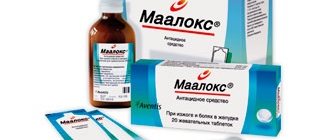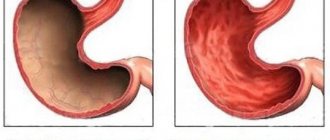10/13/201710/13/2017 Olga Migunova
Increased stomach acidity is a problem faced by half of the population of our planet. This prevalence of this disorder can be explained by the modern rhythm of life, dietary habits and the quality of the products we eat.
In this topic, we will provide you with comprehensive information about what high stomach acidity is, what the symptoms are and treatment for this pathology.
Composition and functions of gastric juice
Gastric juice is a colorless liquid with an acidic pH that is produced by the gastric mucosal epithelial cells.
The composition of gastric juice includes substances such as:
- hydrochloric acid;
- enzymes (pepsin, gastrixin);
- hormones (gastrin);
- slime;
- minerals (sodium chloride, potassium chloride, ammonium chloride, phosphates, sulfates);
- organic components (urea, glucose, acetic and lactic acids).
During the day, about 2000 ml of juice is produced in the stomach of an adult healthy person.
Due to the constant production of hydrochloric acid, the body manages to maintain an acidic environment in the stomach cavity. Therefore, an increase or decrease in acidity in the stomach directly depends on the amount of hydrochloric acid in the gastric juice.
The main task of this enzyme is to break down proteins into small chains, which facilitates their absorption in the small intestine. Hydrochloric acid also takes part in the metabolism and absorption of iron, destroys pathogenic microorganisms that penetrate the stomach, and regulates the acid-base balance in the body.
Hydrochloric acid is produced by the parietal cells of the stomach, which are located on the fundus and body of the stomach.
The following factors may affect the production of hydrochloric acid:
- activity of the autonomic nervous system;
- rough and irritating food;
- acidity level in the stomach;
- motor activity of the stomach walls;
- the amount of gastrin and cholecystokinin-pancreozymin in gastric juice.
The presence of at least one of these factors can increase acidity in the stomach.
Production of hydrochloric acid in the stomach
What is this liquid needed for and what are the risks of disrupting its production? The importance of hydrochloric acid in the stomach is difficult to overestimate, because it is an important part of the digestive process. Changes in acidity lead to inflammatory diseases of the upper gastrointestinal tract, which require serious drug therapy.
Digestion is a complex function of the gastrointestinal tract, which is regulated by the nervous and endocrine systems. Food processing is carried out in several stages, starting with the oral cavity. The main breakdown of components occurs in the stomach. The main role is played by the secretion, which contains hydrochloric acid.
The importance of hydrochloric acid in the stomach can hardly be overestimated, because it is an important part of the digestive process
Hydrochloric acid plays a major role in the complex digestive system. The environment in the human stomach is provided by HCl. It is produced by parietal cells of the fundus and body of the organ. This is where most of it is formed. As it moves towards the antrum, the pH level decreases due to partial neutralization by bicarbonates.
Reasons why stomach acidity increases
All the reasons that cause hypersecretion of hydrochloric acid, and, accordingly, an increase in the level of acidity of juice in the stomach, can be grouped into two groups - external and internal.
External factors include the following:
- psycho-emotional shock;
- neuroses;
- lack of sleep;
- unbalanced and unhealthy diet (fatty, fried and spicy foods, smoked foods, fast food, irregular meals, overeating, strict diet);
- bad habits (smoking, alcohol abuse);
- taking medications that affect the gastric mucosa (non-steroidal anti-inflammatory drugs, hormonal agents, cytostatics);
Internal factors include factors such as:
- chronic stomach diseases (peptic ulcer, cancer, gastritis);
- hyperproduction of the hormone gastrin (pancreatic tumor, increased activity of the stomach glands that secrete gastrin);
- hormonal changes in the body (pregnancy, puberty, menopause);
- metabolic disorders.
Only by identifying and eliminating the cause that provoked the increase in acidity in the stomach can a positive, and most importantly, lasting effect of treatment be achieved.
Treatment
Information on how to reduce stomach acidity should be obtained from a gastroenterologist. Any options for self-medication at home using improvised means are not only ineffective, but can also lead to the development of complications. For symptoms of gastritis with high acidity, diet and treatment include exclusion from the diet of fried and fatty foods, smoked meats, fast food, alcohol, canned meat, fish and vegetables, spices, seasonings, and sauces. You should eat in small portions, 4-5 times a day. Dishes must be prepared mainly by steaming or boiling. In case of increased acidity of the stomach, diet No. 1 according to Pevzner is prescribed.
For symptoms of gastritis with low acidity, treatment and diet include recipes for dishes that stimulate the acid-forming function of the stomach.
To treat high stomach acidity, traditional medicine uses the following groups of pharmaceuticals:
- Antibacterial drugs that are effective for hyperacid gastritis caused by the bacterium Helicobacter pylori.
- Enveloping agents.
- Proton pump inhibitors.
- Antacids.
- H2 histamine blockers.
- Bismuth preparations.
To maintain normal gastric acidity, it is important to maintain a balance of normal gastric microflora. For this purpose, it is recommended to use metaprebiotics, which contain a natural nutrient substrate for gastric and intestinal bacteria. Metaprebiotic Stimbifid Plus helps not only restore the balance of normal gastric and intestinal microbiota, but also promotes the eradication (destruction) of Helicobacter pylori. Also, metaprebiotic components accelerate the process of restoration of the gastric epithelium.
Symptoms of high stomach acidity
Patients with increased stomach acidity may complain of the following:
- heartburn of a constant or periodic nature, especially after eating;
- belching acid;
- bitter taste in the mouth;
- intestinal colic;
- frequent constipation;
- hunger;
- the appearance of a white coating along the midline of the tongue;
- nausea, sometimes with vomiting, which brings relief;
- aching and nagging pain in the epigastrium 2-3 hours after eating.
If you have the above signs of high acidity, then you should not delay contacting a specialist. Timely diagnosis and treatment in this case will help avoid serious health consequences.
Diagnostics
A gastroenterologist is involved in the diagnosis and treatment of diseases that are accompanied by increased acidity in the stomach.
The algorithm for examining a patient with excess acidity in the stomach is as follows:
- collection of complaints;
- collection of anamnesis of illness and life. The specialist is trying to find out the presence of the above external factors that could lead to excess acidity in the stomach;
- examination (bloating, coating on the tongue);
- palpation (pain on palpation in the epigastrium);
- general blood and urine analysis;
- blood chemistry;
- blood sugar test;
- fibroesophagogastroduodenoscopy (FEGDS), which allows you to visually assess the condition of the gastric mucosa and take material for histological examination);
- tests to determine the bacteria Helicobacter pylori in the stomach;
- ultrasound examination of the abdominal organs;
- biopsy and histological examination of the obtained material.
Classification and symptoms
Any problems with the stomach and digestion make you nervous and think about what stomach acidity is, so you should know the symptoms characteristic of various pathologies.
Types of acidity:
- normal;
- increased;
- reduced.
The normal acidity of a person’s stomach confirms that the body is healthy and does not require any medical manipulation; in other cases, diagnosis and treatment will have to be carried out.
Increased
Characterized by concomitant pathologies:
- gastritis;
- duodenitis;
- peptic ulcer of the stomach or duodenum.
How to find out the acidity of the stomach without gastroscopy, with increased secretion - the answer is simple, according to the symptoms, this is:
- heartburn, heaviness in the gastrointestinal tract;
- sour belching;
- nausea, sometimes turning into vomiting;
- constipation
Naturally, an accurate diagnosis will be made at the clinic, but for persons under 40 years of age, and especially males, symptoms should be a reason for mandatory consultation with a doctor.
Reduced
Rarely accompanied by obvious symptoms until atrophic gastritis develops. A downward change in the pH level in the stomach weakens the body's antibacterial barrier, and rotten bacteria begin to actively multiply, which can be seen by bad breath; belching has the smell of rotten eggs.
Interesting! What symptoms indicate zero stomach acidity?
The patient may experience a lack of appetite, constant fatigue and weakness. Along with diarrhea and flatulence, constipation may occur. Low acidity often leads to allergic reactions.
Methods for determining acidity in the stomach
Acidity in the stomach can be determined using special laboratory tests.
- Express method. There are special test strips (Acidotest, Gastrotest) that allow you to instantly determine the acidity in the stomach. To do this, you need to dip the strip in the urine and after 2-3 minutes evaluate the result on the scale that is printed on the test package. This method has low efficiency and is therefore rarely used.
- Probing of the stomach is fractional. A rubber probe is inserted into the patient's stomach, through which samples of juice are taken from the bottom, body and pylorus, after which the material is delivered to the laboratory, where the acidity is determined. This method also has its own errors.
- pH-metry of the stomach. A probe is inserted into the stomach, which is equipped with pH sensors. Using such sensors, you can measure acidity in different parts of the stomach. This method is considered the most accurate.
Normally, the acidity in the stomach should be between 1.5 and 2.0 pH.
Hydrochloric acid production mechanism in the stomach
The formation mechanism begins from the moment a person catches the smell of food. The parasympathetic NS (nervous system) is activated, acetylcholine and gastrin irritate the receptors of the parietal cells, which leads to the onset of hydrochloric acid production. Its secretion occurs while food is in the stomach. After its evacuation into the intestine, synthesis is blocked by somatostatin.
As food moves forward, it enters first the acid-forming and then the acid-neutralizing zones of the stomach. They are separated by an intermediary zone, which corresponds to the transition of the fundus to the antrum. Therefore, a slightly acidic environment with a pH level of 4.0-6.0 is replaced by a strongly acidic environment, where the pH is less than 3.0.
The main acid-forming function is performed by hydrochloric acid in the stomach. Correction of acid formation is carried out by hormonal and biologically active components as the chyme moves. The fundic glands of the body and antrum secrete acid. The process is regulated with the help of histamine. This substance is produced when the walls of the organ are stretched by food.
Gradually, the concentration of gastric juice increases, which leads to the activation of somatostatin. It blocks the secretion of hydrochloric acid. Another neutralizing mechanism is bicarbonates, which make food alkaline. An optimal environment with low acidity is needed for the reflex opening of the sphincter and the creation of normal peristalsis in the stomach and duodenum.
Hypersecretion of hydrochloric acid causes retention of chyme in the stomach; its deficiency leads to its premature entry into the intestine. The process of fermentation and absorption of nutritional components is disrupted.
Treatment of high stomach acidity
Acidity in the stomach can be normalized with the help of modern antacid medications. But you need to understand that any medicine can only be prescribed by a specialist, since self-medication can cause irreversible harm to health.
The most effective drugs that are used for excess stomach acidity are the following:
- Gastrocepin;
- Phosphalugel;
- Rennie;
- Ranitidine;
- Omeprazole;
- Pantoprazole.
Prognosis and prevention
Therapeutic and preventive measures for increased stomach acidity are primarily based on maintaining a balanced diet:
- exclusion from alcohol consumption;
- fatty and spicy foods;
- thoroughly chewing food lumps;
- enriching the body with plant fibers, natural microcomponents and vitamin groups.
If high acidity is not treated, then treatment becomes more complicated over time. Damage to the mucous membrane leads to prolonged gastroesophageal reflux, which develops into a gastric ulcer, and subsequently, possibly a malignant formation.
Take care of yourself and always be healthy!
Review of drugs for the treatment of high acidity
Gastrocepin
The drug Gastrocepin
This drug is available in the form of tablets and solution for injection, the active ingredient of which is pirenzepine - a substance that blocks muscarinic receptors and reduces the secretion of hydrochloric acid.
Gastrocepin is used for stomach diseases that are accompanied by high acidity (peptic ulcer, gastritis).
This drug is contraindicated in persons with allergies to its components, as well as with severe renal impairment and paralytic intestinal obstruction. In addition, Gastrocepin is not recommended for use by children, pregnant and breastfeeding women.
Gastrocepin is taken 2 tablets (50 mg) twice a day half an hour before meals.
Cost of the drug: Gastrocepin 25 mg 50 tablets – 270-430 rubles.
Phosphalugel
The drug Phosphalugel
Phosphalugel belongs to antacid drugs and is a gel consisting of aluminum phosphate, pectin, sorbitol and agar-agar.
The main indication of the drug is stomach diseases that are accompanied by excessive acidity (gastritis, stomach ulcers, gastroesophageal reflux). The drug can also be used in complex therapy of intestinal infections, poisoning and diarrhea.
Phosphalugel is contraindicated in persons who are intolerant to aluminum phosphate and other components of the drug. Can be used in children and pregnant women as prescribed by the treating doctor.
Phosphalugel is prescribed to adults 1-2 sachets two or three times a day two hours after meals. For children, a single dose of 1-2 teaspoons is recommended.
The average cost of the drug is 230 rubles per package (20 sachets).
Rennie
The drug Rennie Rennie is an antacid drug with a gastroprotective effect, the active ingredients of which are magnesium and calcium carbonate.
Rennie tablets are available in menthol and orange flavors. The mechanism of action of the drug is to neutralize hydrochloric acid, thereby reducing the acidity in the stomach cavity.
Rennie is widely used for stomach diseases that are accompanied by excessive acidity, as well as for heartburn of various natures.
Rennie is contraindicated in patients with allergies to magnesium and calcium carbonate, severe renal failure and hypercalcemia. Rennie tablets can relieve heartburn in pregnant women.
Adults and children over 12 years of age are recommended to dissolve 1-2 tablets for symptoms of excess stomach acidity, but the daily dose should not exceed 16 tablets.
The average cost of the drug is 250 rubles per package (24 tables).
Ranitidine
Ranitidine belongs to a group of drugs that block histamine H2 receptors. The drug is widely used in the treatment of gastric ulcers, since, by reducing acidity, it creates a favorable background for the healing of ulcers and erosions.
Ranitidine is not recommended for use by pregnant and nursing mothers, children under 14 years of age, patients with renal failure and persons with allergies to the components of the drug.
The dose is selected individually by the doctor. In most cases, patients are prescribed 1 tablet (150 mg) twice a day. The duration of treatment is also determined by specialists and averages 1-2 months.
The average cost of the drug is 60 rubles per package (20 tables).
Omeprazole and Pantoprazole
Both drugs belong to the group of proton pump inhibitors.
Omeprazole and Pantoprazole
The active substance of Omeprazole is omeprazole, and Pantoprazole is pantoprazole sodium sesquihydrate.
Both drugs inhibit the functioning of the glands that secrete hydrochloric acid by blocking the proton pump of the parietal cells of the gastric mucosa.
Omeprazole and Pantoprazole are used in the treatment of peptic ulcers, hyperacid gastritis, gastroesophageal reflux, and are also included in the treatment regimen for Helicobacter pylori.
These drugs are contraindicated in persons with hypersensitivity to their components and in children under 12 years of age. Can be prescribed to pregnant women.
Omeprazole is prescribed 1 tablet (20 mg) in the morning an hour before breakfast.
Pantoprazole is taken one hour before meals, 1 tablet (20 mg) once a day.
Average cost of drugs:
- Omeprazole 20 mg 30 tablets. – 80 rubles;
- Pantoprazole 20 mg 28 tablets. – 210 rubles.
All patients suffering from high stomach acidity are prescribed a diet.
general information
In 80% of cases, the cause of the development of the inflammatory process with high acidity of the stomach is the microorganism Helicobacter pylori, which disrupts the natural protective properties of the stomach and leads to damage to the epithelium of the organ. Gastritis with high acidity can develop in people regardless of age, including children.
Other factors predisposing to the development of this condition include:
- Regular exposure to stress on the body.
- Poor nutrition, predominance of fried and fatty foods in the diet, as well as deep-fried dishes.
- Abuse of so-called snacks.
- Long-term or uncontrolled use of drugs from the group of non-steroidal anti-inflammatory drugs. Frequently eating food that is too hot or too cold. In addition, people with thyroid diseases, diabetes mellitus and gout have a high predisposition to the development of hyperacid gastritis.
Why is high acidity dangerous?
Gastric juice contains hydrochloric acid, which is necessary to break down food components. To prevent the acidic environment from damaging the walls of the stomach, protective mucus is produced. With increased acidity of the stomach, destruction of the mucous protective layer is observed, followed by the formation of an inflammatory process, the formation of erosions and ulcers.
Clinical symptoms
Inflammatory damage to the organ with increased secretion of gastric juice often worsens during the off-season, in the autumn or spring months. Symptoms of high stomach acidity include:
- Drawing or cramping pain in the epigastric region, which often intensifies after eating. In the acute course of the inflammatory process, the pain may be accompanied by vomiting, which brings temporary relief.
- Heartburn, which is caused by acidic stomach contents refluxing into the esophagus.
- Belching sour.
- Bad breath.
- Stool disorders such as constipation or diarrhea.
Other symptoms of increased stomach acidity during gastritis include weakness, dizziness, increased sweating, excessive gas formation in the intestines (flatulence), increased salivation, increased or decreased appetite, and the appearance of a white or gray coating on the surface of the tongue. Reduced stomach acidity is accompanied by symptoms such as decreased appetite, a feeling of heaviness in the epigastrium, and rotten belching.
Treatment options
After a diagnostic examination, the doctor will be able to make an accurate diagnosis and prescribe appropriate treatment. The main goal of therapy is to normalize the level of hydrochloric acid in gastric juice. For this purpose, various treatment methods are used, including taking medications, a therapeutic diet and the use of traditional medicine.
Features of treatment
Pharmacy drugs
To normalize the acidity of the stomach, the patient is prescribed drugs of different groups. Only a doctor knows which medicine is suitable in your particular case, so you should not self-medicate.
Table. Review of drugs to normalize stomach acid.
| Name of the drug, photo | Description |
| Omeprazole | A common medication used as a depressant that stabilizes the secretion of gastric juice. It has several contraindications, so be sure to read the instructions before using it. |
| Ranitidine | An antiulcer drug that belongs to the group of histamine blockers. It is often prescribed for the treatment of various gastroenterological diseases, including increased stomach acidity. Available in tablet form. |
| Gastrocepin | The action of this drug is to block cholinergic receptors, as well as to form a protective barrier on the walls of the stomach, which protects them from the negative effects of hydrochloric acid. The product belongs to the group of antacids. |
| Baking soda | The action of soda is to neutralize hydrochloric acid in the patient’s stomach, so it is often used for high acidity of the stomach. But here you need to be extremely careful, as an overdose can harm your health. Therefore, all actions must be coordinated with the attending physician. |
| Almagel | Another drug whose action is based on stabilizing the production of hydrochloric acid. The active component is aluminum hydroxide. |
To avoid serious consequences, you must coordinate all your actions with your doctor. Otherwise, you risk not only not being able to cope with the pathology that has arisen, but also triggering the emergence of other health problems.
Folk remedies
Traditional medicine is often used as a complement to traditional therapy. There is still no official confirmation of the effectiveness of using traditional medicine for high or low stomach acidity, but this does not stop traditional healers.
Treatment with folk remedies
The most common folk remedies are:
- freshly squeezed aloe vera juice;
- chamomile tea;
- ginger decoction, which improves digestive processes in the body;
- liquorice root;
- mastic (you can easily find it in health food stores).
Aloe vera juice
But despite the naturalness of traditional medicine, their improper use can lead to undesirable consequences . To avoid trouble, you need to consult a doctor. First of all, this is necessary to exclude an allergic reaction to individual components of the medicine.
Nutrition
Following a special diet is another important part of treatment. As a rule, it is aimed at normalizing the functioning of the gastrointestinal tract. First of all, the patient should exclude from his diet:
- strong tea and coffee;
- berries, citrus fruits;
- sweets;
- carbonated drinks;
- fatty, fried, sour and spicy foods;
- rich soups.
Products with high and low acidity
At the same time, you need to add the following products to your diet:
- boiled potatoes, cauliflower;
- steamed egg omelet;
- mineral still water;
- crumbly porridge (buckwheat, rice, oatmeal);
- vegetable puree;
- lean varieties of fish and meat;
- low-fat fermented milk products.
Medical nutrition
On a note! It is advisable to replace tea and other drinks with clean water, and doctors recommend eating in small portions, but often. This will avoid overeating, which negatively affects the stomach and other organs of the gastrointestinal tract, overloading them. Only if you follow the right diet can you count on a quick recovery.
Diagnosis of acidity disorders
Diagnostic procedures for hyperacid inflammation of the stomach are carried out to clarify the depth of damage to the organ wall, assess the level of secretion of hydrochloric acid, enzymes, hormones, and identify the cause of the disease.
- Fibrogastroduodenoscopy (FGDS) allows you to see changes in the inner lining of the stomach and take material for a biopsy.
- pH-metry is carried out directly in the stomach cavity or when collecting digestive juice using a probe. Acidity is determined on an empty stomach and after stimulation.
- A blood gastrin test helps determine the presence of Zollinger-Ellison syndrome.
- An ultrasound of the pancreas is performed to visualize the tumor.
- Microscopic examination of biopsy material makes it possible to determine the cellular composition of the mucosa and identify the presence of H. pylori.
- Non-invasive breath tests are also used to diagnose Helicobacter pylori infection.
Diagnostic manipulations must be carried out before the start of antisecretory therapy, since the pH values against this background are normalized and will not allow a correct diagnosis to be made. Therefore, medications for high stomach acidity are discontinued 1-2 days before FGDS.
Long-term therapy with antisecretory drugs leads to changes in the vital processes of H. pylori and it becomes difficult to detect during a breath test. The urease test gives a false negative result, the patient is prescribed the wrong treatment, which leads to the progression of gastritis.











